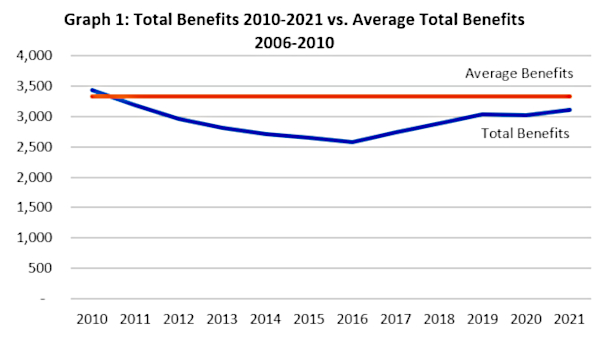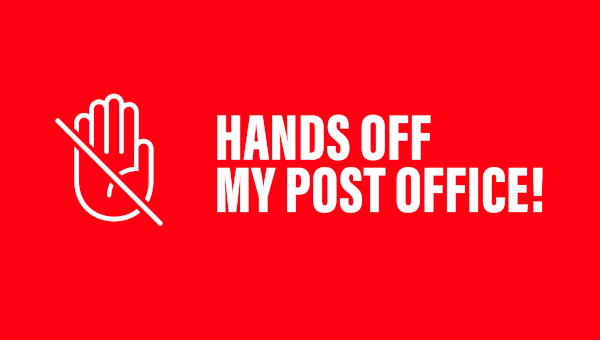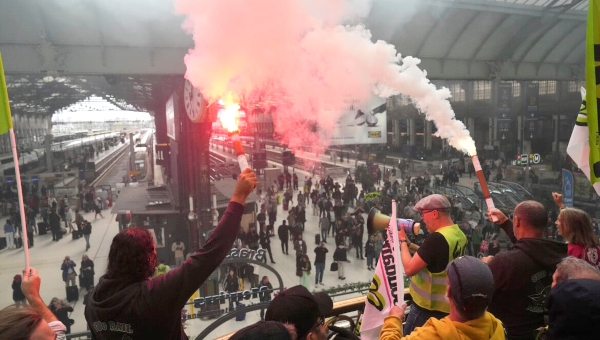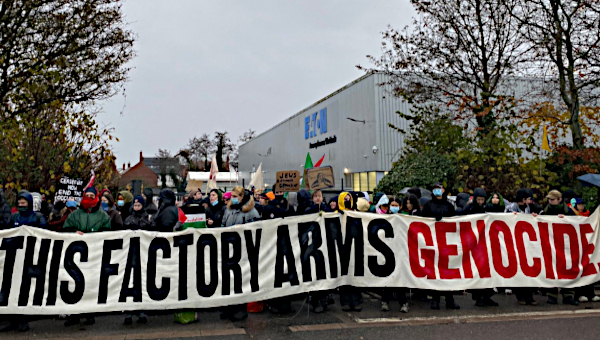Education Workers Lead But Come Up Short: What Lessons for Labour?
Education Workers lead but come up short: What lessons for labour? In early November of this year an all-too familiar story seemed to be unfolding in Ontario. In this case, the 55,000 education support staff workers who are members of CUPE (Canadian Union of Public Employees), Canada’s largest union, were approaching a deadline. The government negotiators had presented their final offer. Workers were about to exercise their right to withdraw their labour. It could be assumed that the Ontario Conservative government led by Doug Ford would do what other governments before it had repeatedly done: pass legislation to end the strike in the name of the ‘public interest’.
In this re-run of many public sector negotiations, labour leaders could be expected to go on about labour rights and democracy, but when facing the coercion of the law and fines they call on their members to return to work. And the members, feeling they had no choice, would follow the past pattern and reluctantly comply. This time, however, something different happened: the education workers refused that charade, and the conflict took a dramatically distinct and even historic turn.
The divergence from earlier experiences began with the way the Ford administration tried to end the strike. Rather than wait until the strike was actually on, Ford used his parliamentary majority to pass legislation that criminalized the right of these workers to strike even before they actually went out (in the infamous Bill 28, Keeping Students in Class Act). With inflation running just under 7%, the legislation imposed a collective agreement offering 2.5% for workers earning under $43,000 annually and 1.5% for those earning above that princely sum. (The distinction the government made between low-paid and less low-paid workers was perhaps intended to push 1.5% as the standard for future collective bargaining in the public sector with the additional sum for lower-paid workers an ‘exceptional’ add-on for this sector alone.)
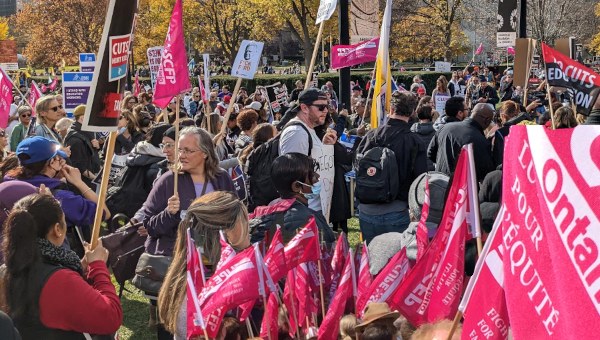
Threats of Fines and Legislation
With profits booming and inequalities already at historic levels, the legislation imposed real wage cuts of roughly 4.5 – 5.5% in the first year of the agreement. And as was the norm in such episodes, Ford’s dictate was backed by heavy fines on those who dared to resist: $500,000 each day on the union, and $4,000 daily for each striking worker. For some half of the workers, two weeks on strike would amount to forfeiting their entire annual income to fines.
Bill 28 included a further step, controversial even outside labour circles. To protect the government from a constitutional challenge on pre-empting the right to strike, Ford turned to a notorious loophole in the constitution – the infamous ‘notwithstanding’ clause – to immunize his government from a subsequent challenge to the legislation, including any challenge under the Human Rights Code or the Ontario Labour Relations Act. At the end of November, Ontario’s Supreme Court of Justice deemed the earlier legislation of a 1% cap on public sector wage bargaining unconstitutional, precisely the kind of ruling that Ford was trying to circumvent.
The main break with past collective bargaining came next. Unlike earlier labour responses, the education workers rejected the script. Across the province, school custodians, maintenance workers, education assistants, early childhood educators, lunchroom and safety monitors, librarians, and office staff ignored the legislation and walked out.
The audacity of the education workers galvanized the larger labour movement against Ford’s authoritarian over-reaction. On the ensuing weekend, after the first day of the strike, rumours spread of an imminent escalation of the conflict. A press conference was called for Monday morning (Nov. 6) where unions leaders were to announce a ‘general strike’. What was so recently unthinkable – a province-wide shut-down – seemed to have become an actual possibility.
But before the labour leaders could make their announcement, a chastened Ford again took pre-emptive action. The Premier, “stammering and appearing shaken by days of unanticipated opposition,” announced he would fully repeal the anti-labour legislation. The belligerence of a few days earlier gave way to a conciliatory “I don’t want to fight… I’m past the stage of fighting.”
With this, the government’s once definitive ‘final offer’ also became flexible. In response to the union’s demand to ’put more money on the table’ Ford conceded that the government would indeed increase the wage offer if the workers ended the strike and returned to the bargaining table. The union complied and on November 20, the two sides announced a tentative agreement. It included monetary gains, though short of workers’ hopes, but no gains on staffing. More than two weeks later, 76% of members voted on the tentative agreement with 73% voting for ratification (it’s unclear why ratification took more than two weeks).
This chain of time-compressed events poses a number of questions with longer-term strategic implications for labour. Why was the government so adamant about preventing this strike? What explains the readiness of the workers to do what others in a similar position so rarely did? What role did the threat of a general strike play? Where did the public, especially parents, stand on this conflict? Should the union have stayed on strike, waiting until an adequate offer was received and ratified? Did the workers ultimately win or lose? Most important, since this was only one battle, however significant, in a wider on-going struggle, what concrete lessons does it hold for the labour movement going forward?
Context: When a Strike is More Than a Strike
Like other public sector workers, the education workers had suffered under the 1% cap on wages in their last agreement. Over the past decade (2012-2021), their real wages had fallen by some 10% as prices increased by 19% while wage increases were under 9%. Moreover, while all workers have been hard hit over this period, Ontario’s education workers’ wages fell further behind the province’s broader public sector, where average wages had increased by 12.2%. Federally regulated workplaces had seen their wages increase by 18.6%, municipal unions by 19.1%, and private sector workers by 20.3%.
The education workers’ 1% wage cap had expired with the end of their previous collective agreement, ‘freeing’ CUPE to bargain without that cap – the first major agreement to be in that position. This set the stage for the face-off with the government. For the Ford administration the demands of the education workers were not just about one sub-sector but a Trojan Horse for gains across the public sector. They had to be aggressively contained.
This morphed a ‘normal’ conflict with a set of employers (the school boards) into what was essentially a political strike against the government. The dilemma for the union was that in spite of the conflict’s significance for the entire public sector (and less directly, for private sector bargaining), the battle was being led and fought by only a sub-sector of the union movement.
Further militating against the aspirations of the education workers was that the prevailing mood of labour as a whole was characterized by a dispiriting passivity. It is true that there were some hints of a reawakening within the labour movement. OPSEU’s (Ontario Public Sector Union) college strike and ATU’s (Amalgamated Transit Union) GO bus strike had generated some optimism. So too did progressive changes in union leadership in OPSEU, Unifor, and the Toronto elementary teachers. But the grumbling across unions over the 1% caps on wages included little or no substantive resistance. Strikes in the public and also private sectors were at an ebb. Tentative agreements were rarely rejected. Wildcats were almost unheard of. Especially damaging, the teachers that worked alongside the education workers were, from the very beginning, cool to disrupting the schools again. This made it all the harder to ask for support from unions less directly involved.
Of concern as well to the union was the likely response of parents. Parents had experienced the negative impact of COVID on their kids’ education and with their kids at home, they faced interruptions in their own work. Even though the union had prioritized its concern for kids and their parents in its emphasis on improving badly-needed school services, and there had been very impressive organizing among parents by the Ontario Parents Action Network, Ford would no doubt try to position himself as the defender of in-school learning against its ‘disrupters’.
Even though CUPE instantly declared it would pay the fines levied against its members, the overall context faced by the education workers weighed against this being a good time to strike. How then was it that these workers nevertheless had the audacity to take on Ford and the law?
Organize, Organize, Organize!
Accumulated frustrations and the courage of the workers were certainly factors in trying to understand the walkout. Yet the frustrations were hardly new and a good number of workers throughout the province were no less frustrated without engaging in any comparable response. Similarly, these were certainly not the only workers with courage; courage alone is rarely enough of a causal factor.
The great achievement of the strike, short as it was, was the demonstration that workers can in fact take on their employers and win at least partial victories, even when the cards are stacked against them. The system may favour the priorities of capital (not for nothing is it called ‘capitalism’), but “without our brain and muscles not a single wheel would turn.” This however includes a very big ‘IF’ – it can only happen if unions do the intensive organizing to manifest the potential power of workers.
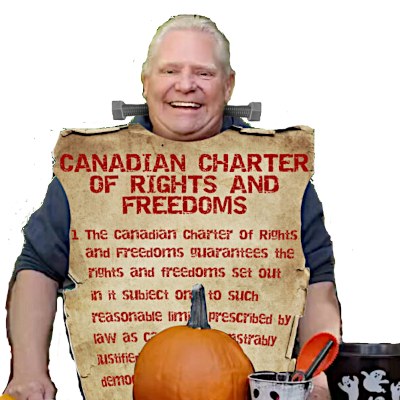
It cannot be emphasized enough that the determining factor in this rebellion was the remarkable education and organizing carried out among education workers through some eight months leading up to the strike. Inspired by the methods of the iconic American organizer Jane McAlevey, the union systematically developed the understandings, capacities, and confidence of its members. Expectations were raised. Weaknesses were identified and progress measured through ‘structure tests’. Critically, the goal was not just to get a strike vote but to achieve super-majority support with depth.
Without that deep organizing by the union of the base, there might have been much ‘sound and fury’ but no concrete response. The generalized fatalism that permeated the labour movement would likely have persisted. There would not have been cause for union leaders to contemplate a general strike, leaving it instead to the courts. And without the strike threat, there would have been no dramatic retreat from the Premier. What Ford and his advisors underestimated was not the existing mood of workers but their mood and capacities if they were organized.
That preparation was registered in the strike vote. Some 80% of the workforce participated in the vote and 96.5% of those voted to strike, meaning that almost 4 in 5 workers (77%) actively supported the strike. To put that in perspective, in the previous provincial election, 43% of the electorate voted and of those only 40% voted for Ford, giving him the support of less than 1 in 5 citizens (17%).
Still, since the workers were in essence not just bargaining with a particular employer but essentially looking to reverse broader attacks on workers’ income and public services, an escalation of their work stoppage beyond the education workers seemed crucial. This is where talk of a general strike entered the discussion.
General Strike?
For many on the left, the possibility of a general strike was an exciting game-changer, rich in openings for organizing workers. A general strike, or even a very uneven attempt at one, holds out the possibility of unleashing submerged anger, invites creative working-class resistance, encourages the kinds of conversations and questions among workers that could raise class consciousness to a new level. Out of this might even come a new generation of leaders and a reawakening of a working class with new and more radical ambitions.
These are hopeful sentiments. But we need to be sober about the state of the labour movement and what it takes to pull off even a partially successful general strike (see especially the account by Herman Rosenfeld). If we credit the pre-strike organizing by education workers for their illegal walk-out, a corollary is that since labour as a whole generally has done so little of such organizing, it could not have successfully pulled off much of a general strike. The above optimism over what might emerge from a general strike does not tell us how to actually achieve a general strike.
Consider. The teachers, as noted earlier, were not supportive of the education workers’ disruption of classes and this didn’t bode well for other sectors walking out. Would public sector workers who suffered the 1% cap without their own unions putting up much of a fight take the sudden call for a general strike seriously? Ditto private sector workers, whose unions often defended and even sold concessions such as two-tier wages to their members. Moreover, would we expect – or even want – workers to go on a general strike when they haven’t been consulted, the strategy hasn’t been debated, no education has occurred, and no larger plan articulated?
Nor was it even clear what the union leaders intended by a ‘general strike’. Did they mean an indefinite strike or – more likely – a one, perhaps two-day strike which, though of consequence would essentially amount to another protest rather than a fundamental challenge to authority (protests had preceded the talk of a general strike; they were spirited and not insignificant, but far from overwhelming).
In any case, the proposed general strike wasn’t actually over the workers’ demands, but the Premier’s especially authoritarian legislation. Once that law was repealed, so too was talk of a general strike. And based on what we saw in the media and heard from other channels, while the labour leadership was rightly proud of getting Ford to step back, it seemed quite universally relieved that their threat of a total provincial walk-out would not be tested.
And yet Ford did back down in the shadow of labour’s threat of an all-out war with his government. What are we to make of this? Though speculative, it seems that it was not so much the fear of a successful general strike that moved Ford, but a growing web of contradictions. He had been trying to carry the populist banner of representing ‘the little man’ and nurturing labour leaders to his side. But the chain of events that the education strike set off exposed his true anti-worker colours and lost him the seven endorsements, primarily from unions in the construction trades, that he had previously recruited.
Ford and company had also relied on the anger of parents over the closing of schools being focused on the workers. But Ford’s across the board record came back to haunt him. Parents had experienced the Ford administration’s mishandling of COVID. They readily linked the cutbacks in health care to the crises in long-term homes and emergency wards, issues impressively highlighted by the Ontario Health Coalition and health care unions. And parents had witnessed the government’s refusal to invest in the physical and social infrastructure of schools as well as in smaller, more effective class sizes.
On this score, the subterfuge of government deficits was exposed as exaggerated and Ontario’s low ranking in per capita expenditures pointed to a problem with priorities, not a lack of funds and to Ford’s class-biased resistance to seriously tax the grossly accumulating wealth of the rich. All this undermined Ford’s intended image as the saviour of parents and turned parent anger on Ford himself. Isolated in his quest for friends in labour and losing the contest over who was to blame for closed schools, Ford retreated.
None of this denies that general strikes can be a crucial instrument in labour’s arsenal in the struggle to make our society more democratic and equal and our lives more secure and meaningful. But ill-prepared general strikes may also expose the weakness of the labour movement rather than showcase its potential. And general strikes are not necessarily the strategic pinnacle of labour opposition.
Consider the contrast with the Days of Action in the mid-1990s. In that earlier period the labour movement understood that it didn’t have the strength to call and sustain a general strike. The alternative chosen was to turn to a series of community shut-downs. This allowed labour to start with communities where it was stronger, concentrate their best organizers there, spend a good deal of time to prepare for each action, and ultimately sustain the protest over eleven one-day regional strikes over two and a half years.
In present circumstances, where an indefinite general strike is likewise not on – at least not yet – might it be more strategic to contemplate a series of protests and disruptions over time rather than a concentrated general strike (or perhaps as a prelude building to a general strike)? This might, for example entail stopping garbage collection in rich neighbourhoods on a Monday, bus drivers not collecting fees on a Friday, protests in the hospital sector the next week, closing schools a few days later and universities sometime after that, and so on.
Why Didn’t CUPE Stay on Strike?
The most vexing question emerging out of the education workers’ strike is how it ended. Rather than following the common union practice of staying on strike until there was a concrete offer on hand and ratified by the membership, the leadership ended the strike, returned to negotiations, and also accepted a blackout on information.
The practical point here is that the return to work took the pressure off the employer. Even if talks broke down and picket lines returned, in the interim the momentum of the strike will likely have been eroded. The democratic point is that staying on strike until workers have seen and ratified a deal gives concrete expression to the promise that ‘the union belongs to the workers’. Furthermore, the labour movement seemed to be solidly behind the strike and polls showed the workers had the support of more than six parents in ten. Why, after all the preparations and this apparently favourable moment, would the union end the strike?
As for the media blackout on information, usually justified as allowing the bargaining to ‘go more smoothly’, this generally comes from employers more concerned with trying to freeze the union’s on-going mobilization. For the union, on the other hand, keeping the members informed was a matter of respecting the wisdom of workers and of the commitment to continuous organizing. Transparent bargaining could also facilitate getting a better read on where the members were at as the conflict progressed.
Moreover, in light of Ford’s recent embarrassed retreat, the union had some leverage in rejecting a bargaining blackout. Anxious to quickly end the strike, Ford would have had trouble delaying bargaining so as to control and block information flows. (The obvious compromise was to put any blackout on hold; if bargaining did seem at some point to demand a blackout this could, through mutual agreement be reconsidered.)
Yet, there were two factors making the continuation of the strike problematic. First, Ford’s eating humble pie changed the dynamics of the bargaining conflict. The labour movement’s prime concern had been Ford’s removal of the right to strike and once that was defeated, the use of that right became secondary. For the labour movement, the negotiations between the education workers and the government drifted towards becoming a more or less ‘normal’ labour-management confrontation.
Along similar lines, the support of parents could not be indefinitely counted on. After Ford had shown some ‘flexibility’ in annulling his legislation and expressing a readiness to modify his final offer, parents could be expected to pressure the union to show a parallel flexibility by ending the strike and returning to negotiations.
It is true that parents cannot be the determining factor for union strategies – the first consideration must be the workers affected – but neither can the reaction of parents be easily dismissed. Parent attitudes can affect the morale of workers and are critical to any future alliance for improvements in school conditions and funding. And with a good number of parents themselves workers, a relationship to parents is also critical to the building of a more coherent working class. Still, risking the loss of parent support might have been the route to go if it weren’t for the second factor.
Continuing the strike demanded a strike-able issue but in moving to a wage settlement, the union undermined both the staffing issue and the possibility of continuing the strike to win more. This clearly requires some unpacking. In doing so, the point isn’t to make judgements with the benefit of hindsight, but to explore some of the dynamics of bargaining to the end of rethinking future tactics/strategies.
The education workers’ opening demands emphasized both large wage increases and increases in staffing that were critical to easing workloads and improving vital but neglected school services. The wage demand, $3.25/hr across the board each year of the agreement, were based on how much the relatively low-paid workers had on average lost in purchasing power over the past decade. The size of the wage increase was a defiant insistence on reversing their members losses and, more generally, reviving working-class expectations more broadly. Though certainly justifiable on moral, egalitarian and solidaristic grounds, the demand far exceeded the wage increases other workers were getting and so seemed to cross the boundary between ambitions and social reality.
The reaction to the wage demand might have been softened a bit and had a more popular resonance if it was broken down into a smaller catch-up increase plus a cost-of-living allowance (COLA) to protect future wages. COLA clauses had once been common in major unions and posing this demand might also have stimulated interest across the labour movement. But such framing is quibbling; the more important point is that in spite of the union’s commitment to improved staffing and services, the unintended consequence of the eye-catching wage demand was that it tended to sideline the other issues.
Later, when the union responded to Ford’s call for a return to bargaining by insisting that the government first put more money on the table, clearly referring to wages, this further reinforced the marginalization of the staffing issue. The union had cut its wage demand in half well before the negotiations were restarted and when Ford conceded there would be an increase in the wage offer, the two parties were pretty close on wages (though not on the form they would take – the employer wanted percentage increases, the union the more egalitarian across the board increases). The strike ended and the two sides got down to hammering out an agreement.
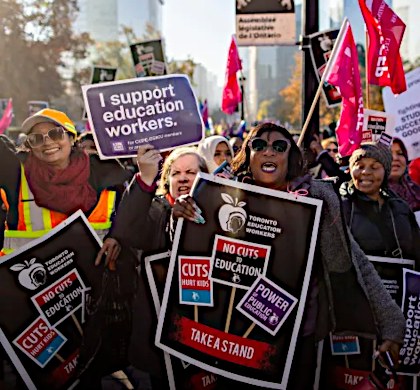
When they did, any pressure on the government moving on staffing was essentially gone. The union could not sustain a strike on staffing alone, which would have been a hard task in any case but certainly after wages, the workers main issue, was settled. Like wages, the call for more staffing went against Ford’s determination to continue reductions in expenditures across the public sector. What was distinct about staffing was that it challenged employers’ sacred ‘management right’ to rule the workplace. Getting the government to bend on staffing would be especially difficult and uncertain.
To have escaped this dilemma, the union would likely have had to concentrate on the staffing issue before getting to wages. This may seem peculiar given that wages were the obvious priority. But there is a distinction between priorities and the tactics of putting a package together. Unions in fact commonly try to address critical workplace and management rights issues before turning to wages, even when wages increases are the main goal.
When Ford offered to modify the government’s final offer in exchange for the union ending the strike and returning to the table, what if the union had responded not by pointing to wages but by leaving the wages to the side – knowing they would in the end return to the centre – and demanding some movement on staffing before they ended the strike? If Ford bit and offered something – anything – that in itself would give the workers a breakthrough to build on. If he didn’t, then twinning wages and staffing (unlike staffing alone) could sustain the continuation of the strike.
As well, that might have been an opportune moment to announce membership meetings a few days hence while staying on strike and testing Ford over the next day or two. If Ford moved quickly towards a settlement the meetings would be ratification meetings; otherwise, the union would be locking the strike in at those meetings. Among other things, this might have been the basis for the strike continuing until the workers had their say – and not just to meet that principle but with some possibility of more gains.
This is of course speculative and would still leave Ford with the option of giving the strike enough time to anger the public and demoralize the workers before ending the strike and sending it to arbitration, where given the allergy of arbitrators to supporting worker breakthroughs, could be safely expected to do nothing on staffing.
Did the Education Workers Win or Lose?
It’s hard to claim a victory when wages will fall even further behind inflation and staffing remains as is. But what can be said is that the internal organizing among the education workers and their readiness to strike illegally mattered. In a mere two days, the education workers had, remarkably, forced an aggressive Premier to back off a law dangerous to the labour movement as a whole, pushed the employer to drop concessionary demands like the erosion of paid sick days, and in spite of Ford’s absolute ‘final offer’, raised wages by a dollar across the workforce in each year of the agreement (a near doubling of the earlier offer).
Beyond this, the education workers were a showcase for implementing systematic member organizing into union strategy and demonstrating that workers can fight back even in the worst of circumstances. The education workers tried to derail the grim austerity agenda the Ford government has been pursuing but fell short. This poses a challenge to the larger labour movement to acknowledge its decades long internal crisis and start to confront seriously what reversing that crisis will mean.
It will take time to assess whether, considering everything, this strike is deemed a win or not. It will take some time to get a read on whether the education workers and the labour movement as a whole came out of this stronger or weaker. Time to learn about the impact on the consciousness and confidence of the education workers and time to see how the union deals with lingering disappointment. Time, that is, to see whether the example of the education workers affects the orientation and culture of the labour movement.
Of the various indicators of whether labour is, at long last, turning the corner, four challenges/tests seem especially pivotal.
1. Organizing
Activists should be pressing the parent union of the education workers CUPE, the largest union in the country, to extend the education/training carried out with such success in its education sector to the rest of CUPE. And activists everywhere should push their union to emulate the internal organizing the education workers did, adapted of course to their own circumstances. Among other things this would require setting up a cross-union school for training instructors. and essentially adding ‘organizing schools’ to the characterization of what unions are.
2. Coordination
It is stunning that in the face of the 1% caps on public sector wage agreements, no systematic coordination occurred across unions. There have been ad hoc attempts to coordinate bargaining in some sectors like health, but it has been limited. Any broader coordination across unions will be difficult, yet with the public sector facing common attacks from the state, it’s surely time for the creation of a permanent council of public sector unions to strategize and build solidarity for the confrontations that we know are sure to come.
3. Addressing Class
While organizing at the base and coordinating at the top complement each other, both need a clear strategic vision. What are workers being educated and trained for? What struggles would coordination prepare workers for? Some four decades ago Doug Fraser, then president of the UAW, clearly identified the emerging reality: “A class war is being waged in this country but only one class is fighting.” This remains true today and workers have suffered immensely for it. If this is to change, workers must come to grips with who they are, who is there with them, and where they ‘fit’ in the system. Class penetrates every aspect of workers’ lives and unless workers integrate class into how they think and act, the future will, if anything, be even worse than the past and present.
4. Union Transformation
Carrying out the above projects is not just a matter of adding certain functions to unions. To deal with them seriously is to recognize that what is at stake is transforming our unions. Truly addressing all of the above means changing union structures and priorities, how unions allocate their funds, the role of the staff, the leadership’s relationship to their members, the unions’ approach to bargaining, and its orientation to ‘politics’.
5. Politics
The problems workers face go beyond any workplace, union, or sector. And at some point we need to clearly address why things are the way they are: Why do inequalities keep rising? Why is there unemployment and why is there inflation? Why do we have a looming environmental crisis? Politics is not so much about good policies as about building the social base so we have the power to see those policies implemented. At the centre of building such a base is the making of a working class with the understandings, coherence, individual and collective capacities, and confidence to make change. At this moment in time, the over-riding political question is how we to organize ourselves so as to build that kind of working class. The Ontario CUPE education workers gave us a glimpse of what is needed and what is possible. Will the labour movement in Canada build on this? There is much more to be done. •


